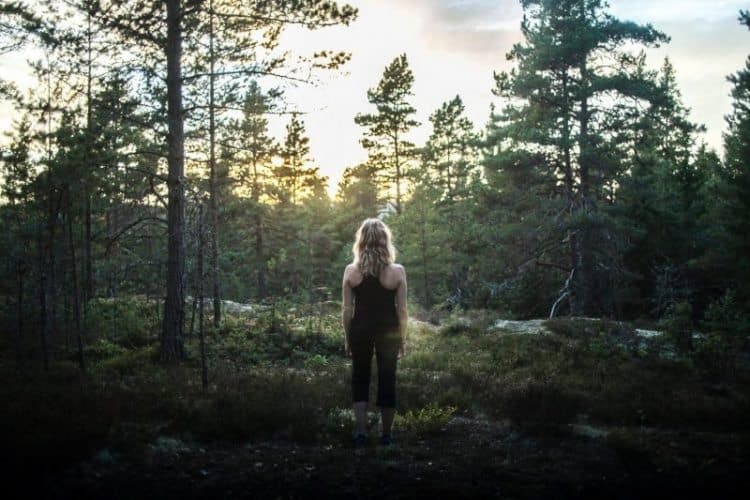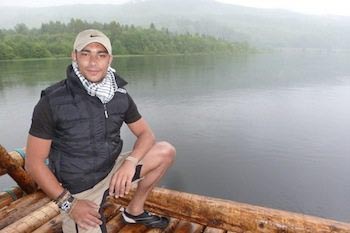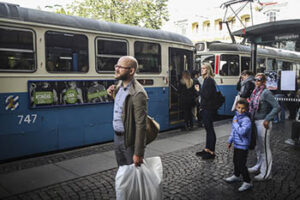
See What Sweden’s DaIsland Has to Offer
By Andy Christian Castillo
“All waters north of Bengtsfors are drinkable,” explained Crister Emanuelsson, owner of Silverlake Camp, right before my girlfriend, Brianna and I pushed off from shore into a series of pristine lakes in Dalsland, a region on Sweden’s West Coast.
Once out on the water, a warm breeze blew through my hair and rustled leaves of trees, pulling ripples onto the lake’s otherwise glassy surface. It had taken us about two hours to drive up from the large city Gothenburg in our rental Volvo XC90 to the campground.
After the car ride, a chance to escape into nature was a welcome opportunity.

In that moment, as the bow of the canoe cut through the water, it seemed as if we were the only living creatures in the world, aside from skimming bugs and distant waterfowl.
We fell into a reach-pull rhythm of rowing and gliding, and soon clipped along at a steady pace.
Brianna sat in front, her flannel shirt tied around her waist, blonde hair pulled up into a messy bun, freckled arms pulling at the oar.
My girlfriend works as a yoga instructor and loves connecting with the outdoors; thus, I imagined she had a big smile on her face as well.
Matching paddle strokes in Dalsland’s pristine lakes
I was seated in the stern, matching paddle strokes with Brianna and guiding the canoe gently on its way. On either side, immense, rolling clouds rose up from above the trees along the shore. Below the shoreline, the clouds seemed to stretch down, symmetrically mirrored on the water’s surface.
Ducks drifted cautiously away from the canoe as we paddled closer to the shore, before taking flight in a thunder of wings, spraying water.
In many respects, West Sweden is similar to the northeastern United States. On the coast, red boathouses, calm inlets, and the region’s peaceful way of life resemble Maine’s iconic coastline, only a bit less commercialized. Dalsland, which is a few hours inland, feels a lot like where I call home in western Massachusetts.
The Swedes have a high quality of life, as rugged as it is enjoyable. A great example of this is the Swedish clothing style. On the west coast at least, it seemed as if everyone was fashionably dressed for a blizzard or freezing rain.
I also found, through various interactions with local residents and transplants alike, that there’s a huge emphasis on land stewardship and keeping the local industry (especially fishing) vibrant, which reminded me of earlier travels along the coast of Nova Scotia in eastern Canada.

About an hour later, around lunchtime, we slowed our paddling and pulled the canoe up onto the short, pebbly beach of a small island in order to enjoy “fika,” a traditional Swedish coffee break.
It was there we learned first hand that Emanuelsson was right: that the majority of the region’s roughly 1,000 freshwater lakes and more than 173,000 square miles of water is so clean it’s safe to drink straight from the lake.
After returning the canoe and saying goodbye to Emanuelsson, we drove about an hour and a half back toward Gothenburg to Dalsland’s Activities.
Over more fika, Pontus Gyllenberg, the activity center’s CEO, explained that the park has about 55 outdoor activities, including two long zip-lines and 10 high-ropes courses, and draws more than 10,000 visitors per summer.
Gyllenberg said Dalsland’s Activities, which opened in 1993, is one of the largest outdoor activity parks in Scandinavia. The center offers self-guided and guided nature experiences and adventures including a Moose Park, kayaking and trail-riding.
After fika, he took us down a short path to the activity center’s Moose Park.

In the evening sunlight, four moose, including a large bull named Elliot, emerged and came close enough for Brianna to most ecstatically check off a lifelong bucket-list-item of seeing and petting a moose.
As he poured buckets of grain into troughs, tempting the moose to venture closer, Gyllenberg explained that the activity center takes in sick or hurt moose that can’t survive in the wild and gives them a safe place to live.
He said that Elliot has lived at the center ever since his mother was killed when he was 2-years-old.
Up to that point, I’d never seen a moose from even a distance, let alone up close and personal — it was exhilarating to see the raw power of nature expressed in the form of a giant bull moose with massive antlers, separated only by a thin wire fence. However, despite their intimidating size and contrary to what I’d believed prior (that moose can be aggressive) Gyllenberg said moose are generally gentle creatures, similar to cows.
That night we followed Gyllenberg in our Volvo just down the road to a few of the center’s historically accurate tipi tents, ruggedly outfitted with animal furs on the inside and beds made of pine needles. Our site overlooked a sprawling lake with a rocky shoreline, on which was situated a wood-fired hot tub.

Before a salmon dinner cooked over a fire outside of the tents, I fished in the lake while Brianna practiced yoga for a little while. Then, at Gyllenberg’s suggestion (who also provided us a wonderful bottle of wine, a Swedish breakfast and homemade brownies), we hiked a narrow path up a small hill, through fern-covered underbrush backlit by red sunlight, emerging at a plateau overlooking the lake.
At the overlook, we sat down against a tree together and watched the sunset, munching on brownies and savoring the sweetness of life’s best offerings.
Travel Tips
- Rent a car because, while there are public transportation routes, the region is spread out.
- Pack a tent because there’s a lot of camping in and around Dalsland.
- There’s pretty good cell-reception in the region, but not many places have wifi. In order to stay connected, we used a data hotspot to get online and that worked just fine.
- Dress warm and for the weather, because the region is deceptively cold and the landscape is rugged.
- Pack a lunch for a picnic — most of the activities are outdoors, and require a pretty good amount of time to really engage in.

Silverlake Camp
66631 Bengtsfors
Brogatan 2
Phone: +460531-12173
Mobile: +46 706655222
E-mail: office@silverlake.se
Website: https://www.vastsverige.com/en/bengtsfors/produkter/silverlake-camp-kanot/
Dalsland’s Activities
Steneby Gård
66010 Dals långed
Phone: +460531-33086
E-mail: info@dalslandsaktiviteter.se
Website: https://www.dalslandsaktiviteter.se/en/
- Chefchaouen, Morocco: The Hashish Farmer’s Home - January 13, 2020
- Moscow: Colorful Architecture Steeped in Military Tradition - December 23, 2019
- Moscow City Day Means Happy Revelers in Russia - September 16, 2019





